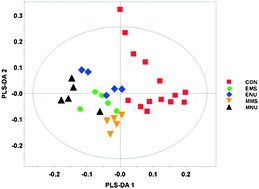A metabolomic and multivariate statistical process to assess the effects of genotoxins in Saccharomycescerevisiae†‡
Abstract
There is an increased need to develop robust cellular model systems which could replace or reduce the need for animals in toxicological testing. Current in vitro strategies for genotoxicity testing suffer from a high irrelevant positive rate, requiring the need for the development of new in vitro tools. Saccharomyces cerevisiae is used widely to study

- This article is part of the themed collection: Computational and systems biology

 Please wait while we load your content...
Please wait while we load your content...